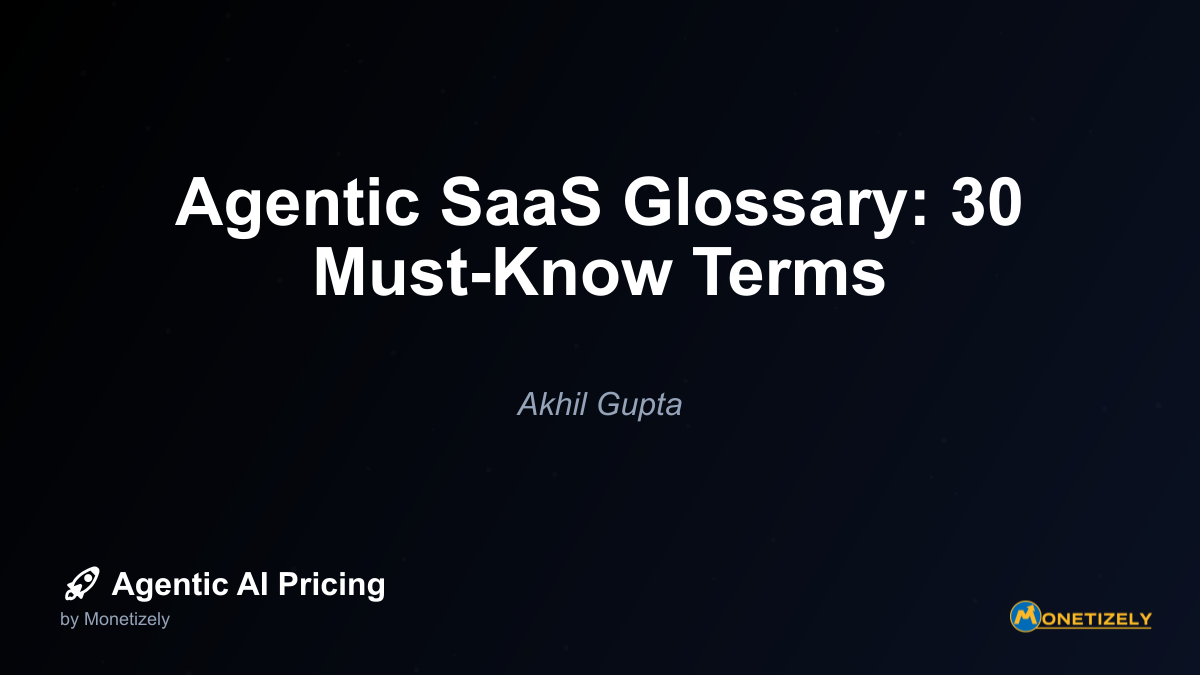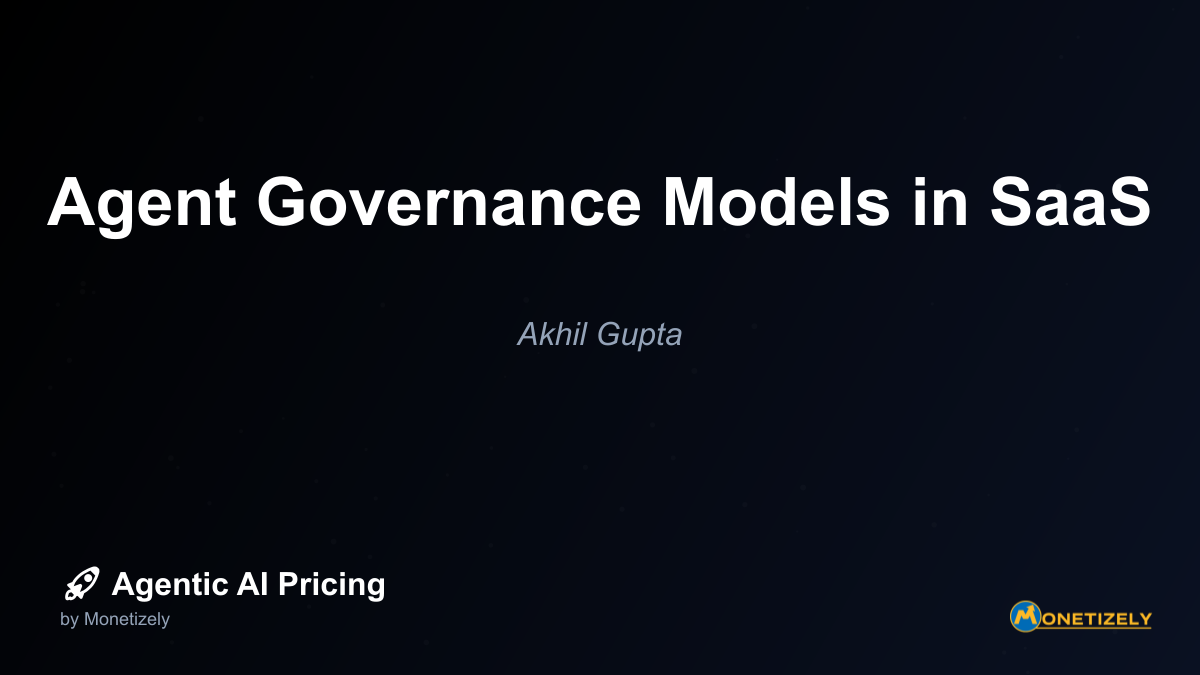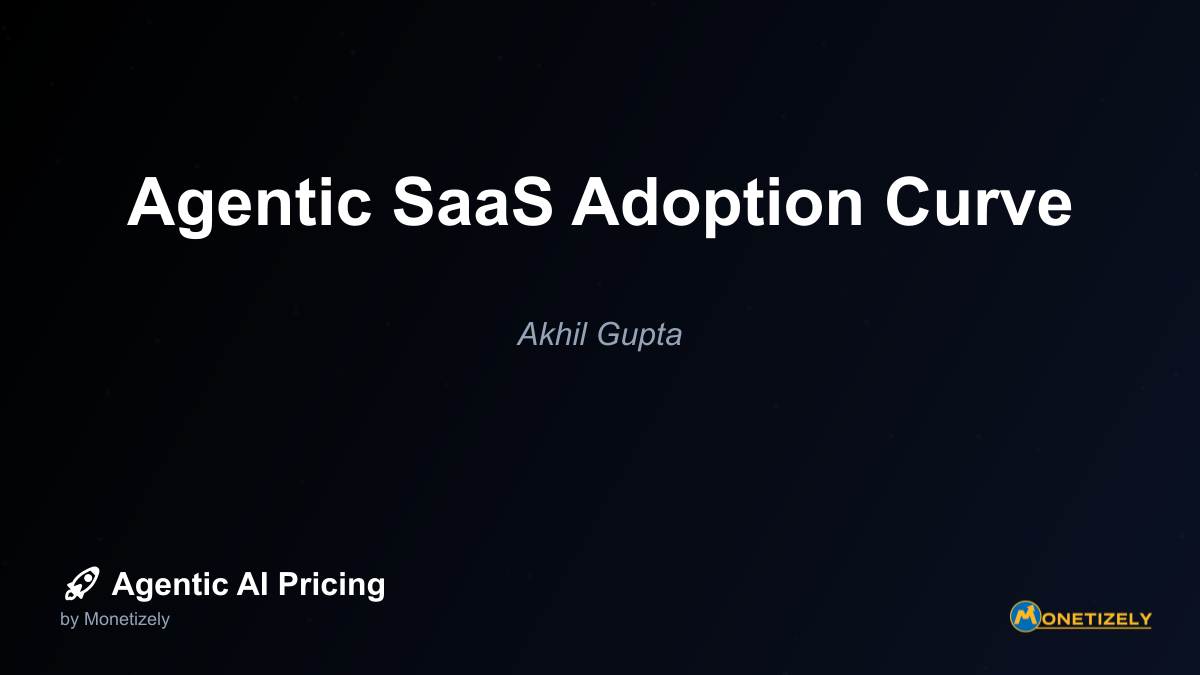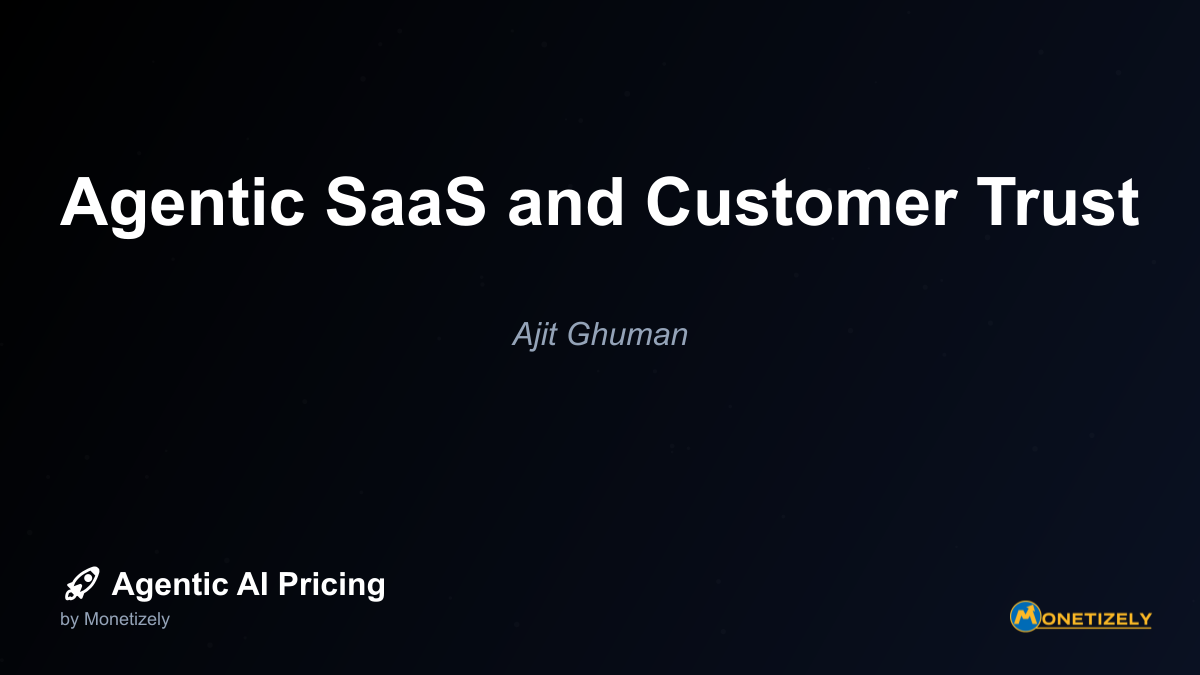· Ajit Ghuman · Agentic SaaS Fundamentals · 8 min read
Agentic SaaS Glossary for Investors
AI and SaaS Pricing Masterclass
Learn the art of strategic pricing directly from industry experts. Our comprehensive course provides frameworks and methodologies for optimizing your pricing strategy in the evolving AI landscape. Earn a professional certification that can be imported directly to your LinkedIn profile.
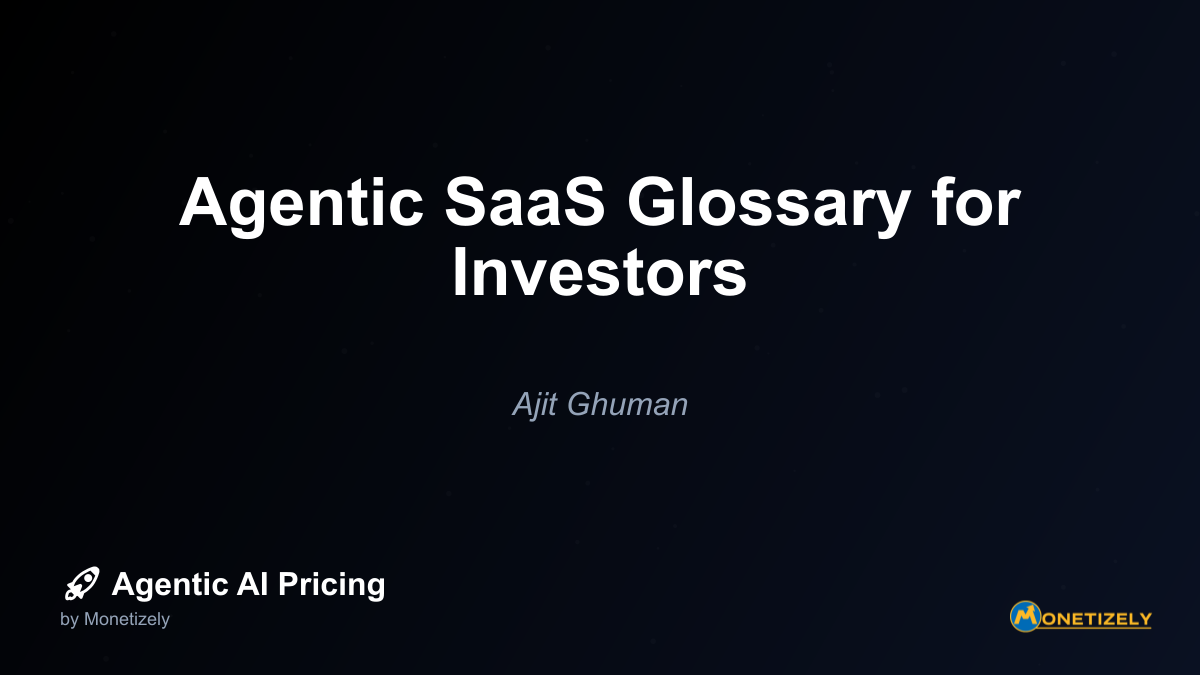
Valuation Metrics
Agent-Adjusted ARR (AAARR): Annual recurring revenue adjusted for the value delivered by autonomous agents. This metric helps investors differentiate between traditional SaaS revenue and higher-value agentic revenue streams.
Agent Development Efficiency (ADE): The ratio of R&D investment to improvements in agent capabilities. Companies with high ADE typically deliver better returns on their technology investments.
Autonomous Value Ratio (AVR): The proportion of customer value delivered autonomously versus requiring human intervention. Higher AVR typically correlates with improved gross margins and scalability.
Pricing Models in Agentic SaaS
Understanding the various pricing approaches is crucial for investors evaluating agentic SaaS companies. Each model carries different implications for revenue predictability, scalability, and customer acquisition economics.
Outcome-Based Pricing
Value-Based Monetization: Pricing based on the measurable business outcomes delivered by agents rather than usage or features. Companies successfully implementing outcome-based pricing often demonstrate premium valuation multiples due to their direct alignment with customer ROI.
Success Fee Structures: Compensation models where the SaaS provider receives payment contingent on achieving specific results. This approach can indicate high confidence in product capabilities but may introduce revenue volatility.
Risk-Sharing Arrangements: Pricing structures where both vendor and customer share in the financial risks and rewards of implementation. These arrangements can accelerate enterprise adoption but require careful investor scrutiny regarding revenue recognition.
Usage-Based Models
Task Completion Pricing: Charging based on the number of tasks successfully executed by agents. This model typically provides high revenue correlation with actual value delivery.
Agent Runtime Billing: Pricing based on the computational time agents spend working on customer problems. While straightforward to implement, this model may face margin pressure as agent efficiency improves.
Data Processing Metrics: Charging based on the volume of information processed by agents. This approach often provides predictable scaling but may not fully capture the value created through agent intelligence.
Hybrid Approaches
Base + Performance Model: A fixed subscription fee plus variable charges tied to agent performance or outcomes. This approach balances revenue predictability with upside potential, making it attractive for many growth-stage companies.
Tiered Autonomy Pricing: Different price points based on the level of agent autonomy required. Higher autonomy tiers typically command premium pricing and indicate advanced technical capabilities.
Capability-Based Segmentation: Pricing structured around specific agent capabilities or specializations. This approach allows for market expansion through targeted solutions for different customer segments.
Market Dynamics and Investment Considerations
Competitive Landscape
Agent Capability Differentiation: How companies distinguish their agent technologies from competitors. Strong differentiation typically supports premium pricing and market leadership positions.
Vertical Specialization: Focus on industry-specific agent solutions versus horizontal platforms. Vertical specialists often command higher prices but in smaller addressable markets.
Integration Ecosystem: The breadth and depth of integrations with other systems and platforms. Robust integration capabilities typically correlate with lower churn and expanded market reach.
Investment Risk Factors
Agent Reliability Metrics: Measurements of system dependability, including error rates and recovery capabilities. Poor reliability metrics often precede customer churn and revenue challenges.
Regulatory Exposure: Vulnerability to changing regulations around AI autonomy and decision-making. Companies with proactive compliance frameworks typically present lower regulatory risk profiles.
Data Rights Management: Frameworks governing data ownership, usage, and privacy in agent operations. Clear data rights policies reduce potential liabilities and compliance costs.
Due Diligence Framework for Agentic SaaS Investments
Technical Assessment
Agent Architecture Evaluation: Analysis of the fundamental design and capabilities of the autonomous systems. Advanced architectures typically support sustainable competitive advantages.
Scalability Infrastructure: Assessment of the technical foundation supporting agent deployment across increasing workloads. Robust scalability infrastructure correlates with improved unit economics at scale.
Technical Debt Profile: Evaluation of accumulated compromises in code quality that might impede future development. Companies with well-managed technical debt typically demonstrate more predictable R&D efficiency.
Market Validation
Customer Success Metrics: Indicators of value realization by existing customers, including ROI measurements and expansion patterns. Strong customer success metrics typically precede accelerating growth.
Adoption Velocity: The speed at which new customers implement and expand usage of agentic capabilities. Rapid adoption often indicates product-market fit and effective onboarding processes.
Referenceability Index: The willingness of existing customers to serve as references for prospective buyers. High referenceability typically correlates with strong retention and efficient customer acquisition.
Emerging Trends in Agentic SaaS Monetization
Consumption Economics
Microservice Pricing: Granular charging for specific agent functions or capabilities. This approach can unlock new market segments and improve pricing efficiency.
Dynamic Pricing Algorithms: Automated systems that adjust pricing based on value delivery, resource utilization, and market conditions. Sophisticated dynamic pricing can optimize revenue realization across customer segments.
Predictive Billing Models: Forecasting customer costs based on historical patterns and projected needs. These systems can improve customer satisfaction while optimizing revenue capture.
Value Capture Innovations
Outcome Sharing Platforms: Systems that distribute value between SaaS providers, customers, and potentially the agents themselves. These novel approaches may represent the next frontier in agentic business models.
Knowledge Asset Monetization: Commercializing the insights and intellectual property generated by agents during operations. This represents a potential secondary revenue stream beyond primary subscription fees.
Ecosystem Revenue Models: Monetization strategies that capture value from the broader network of stakeholders interacting with agentic systems. These approaches can create defensible market positions and multiple revenue streams.
Investment Evaluation Framework
For investors conducting due diligence on agentic SaaS companies, the following framework provides a structured approach to assessment:
Growth Potential Indicators
Agent Capability Roadmap: The planned evolution of agent capabilities and how they will unlock new markets or use cases. Compelling roadmaps typically support premium valuations.
Total Addressable Problem (TAP): The scope of challenges addressable by the company’s agents rather than traditional TAM. TAP analysis often reveals larger opportunities than conventional market sizing.
Network Effect Potential: How agent performance improvements from one customer can benefit others. Strong network effects typically create defensible market positions and expansion opportunities.
Risk Assessment Factors
Dependency Analysis: Evaluation of reliance on third-party technologies, data sources, or platforms. High dependencies may introduce vulnerability to external changes.
Agent Governance Framework: Systems for ensuring agent behavior aligns with ethical, legal, and business requirements. Robust governance reduces compliance risks and potential liabilities.
Competitive Moat Assessment: Analysis of barriers to entry and sustainability of competitive advantages. Companies with strong moats typically maintain pricing power and market leadership.
Learn more about evaluating agentic SaaS pricing metrics as an investorPractical Applications for Investors
Portfolio Analysis
Agentic Transformation Assessment: Evaluating how existing portfolio companies can incorporate autonomous capabilities. This analysis can identify internal investment opportunities and potential synergies.
Capability Complementarity Mapping: Identifying how different agentic technologies in a portfolio can work together. This approach can create strategic advantages through unique combined offerings.
Cross-Portfolio Benchmarking: Comparing key metrics across agentic SaaS investments to identify best practices and improvement opportunities. This analysis supports portfolio optimization and knowledge sharing.
Investment Thesis Development
Capability Gap Analysis: Identifying underserved markets where autonomous capabilities could create significant value. This approach can reveal attractive early-stage investment opportunities.
Adoption Curve Positioning: Determining optimal timing for investments based on market readiness for specific autonomous capabilities. This strategy helps balance risk and potential returns.
Value Chain Disruption Mapping: Analyzing how agentic technologies will reshape industry value chains. This perspective can identify strategic investment opportunities at key inflection points.
Regulatory and Ethical Considerations
Compliance Frameworks
Autonomous System Regulations: Emerging rules governing the development and deployment of autonomous agents. Companies with proactive compliance strategies typically face lower regulatory risks.
Data Sovereignty Requirements: Regulations dictating where and how data used by agents can be stored and processed. Clear sovereignty strategies reduce compliance costs and market access barriers.
Transparency Mandates: Requirements for explainability and disclosure around agent decision-making. Robust transparency capabilities support regulatory compliance and customer trust.
Ethical Investment Considerations
Responsible AI Development: Frameworks ensuring agents are developed and deployed ethically. Companies with strong responsible AI practices typically face lower reputational risks.
Displacement Impact Assessment: Analysis of potential workforce disruption from autonomous capabilities. Proactive approaches to this issue can mitigate social impact concerns and associated risks.
Governance Structure Evaluation: Assessment of oversight mechanisms for agent behavior and decision-making. Robust governance supports sustainable growth and reduces potential liabilities.
Explore usage-based pricing approaches for agentic SaaS productsLong-Term Investment Considerations
Technological Evolution
Adaptability Assessment: Evaluating a company’s ability to incorporate emerging AI advancements. Highly adaptable companies typically maintain competitive advantages over time.
Architecture Longevity: Analysis of how well the underlying agent architecture can evolve without requiring complete rebuilds. Sustainable architectures support efficient R&D investment.
Technical Talent Strategy: Evaluation of approaches to attracting and retaining AI specialists. Effective talent strategies correlate with sustained innovation capabilities.
Market Evolution
Adoption Curve Analysis: Projecting how different customer segments will embrace autonomous capabilities over time. This perspective supports timing decisions for market entry and expansion.
Commoditization Risk Assessment: Evaluating which agent capabilities might become standardized versus remaining differentiators. This analysis helps identify sustainable competitive advantages.
Ecosystem Position Strategy: Determining optimal positioning within the broader agentic technology landscape. Strong ecosystem positions typically support premium valuations and partnership opportunities.
Conclusion
The agentic SaaS landscape represents one of the most promising investment frontiers in enterprise technology. By understanding the specialized terminology, metrics, and frameworks outlined in this glossary, investors can more effectively evaluate opportunities, conduct due diligence, and develop strategic investment theses in this rapidly evolving sector.
The transition from traditional SaaS to agentic models introduces new valuation paradigms, risk factors, and growth patterns that require specialized knowledge to navigate successfully. Companies that effectively harness autonomous capabilities while implementing appropriate pricing and monetization strategies are positioned to deliver exceptional returns as the market matures.
For investors seeking to capitalize on this transformation, developing expertise in agentic SaaS fundamentals is not merely advantageous—it’s essential for identifying tomorrow’s market leaders and avoiding potential pitfalls in this dynamic investment landscape.
Co-Founder & CEO
Ajit is the author of Price To Scale, a top book on SaaS Pricing and is the Founder of Monetizely. Ajit has led and worked in pricing and product marketing at firms like Twilio, Narvar and Medallia. His work has been featured in Forbes and VentureBeat. Ajit regularly consults with software companies from Seed stage to post-IPO on pricing strategy. Ajit is also a highly-rated co-instructor for 'The Art of SaaS Pricing and Monetization' on Maven.
Pricing Strategy Audit
Let our experts analyze your current pricing strategy and identify opportunities for improvement. Our data-driven assessment will help you unlock untapped revenue potential and optimize your AI pricing approach.

